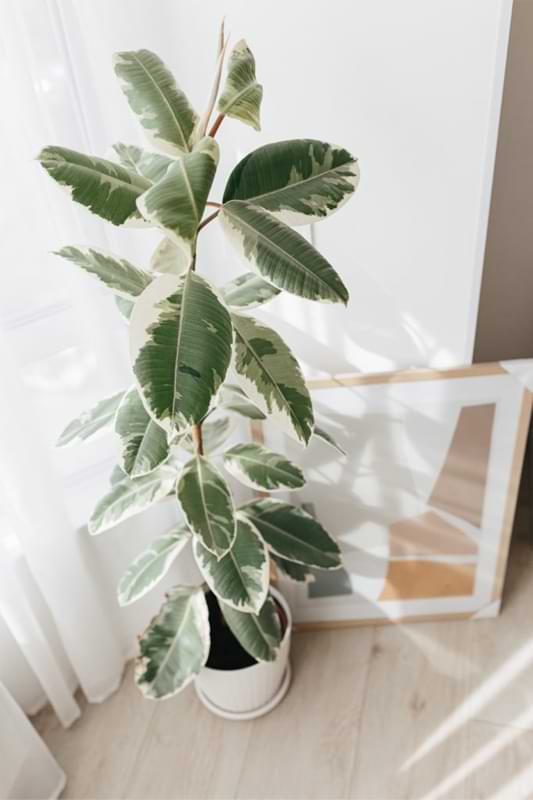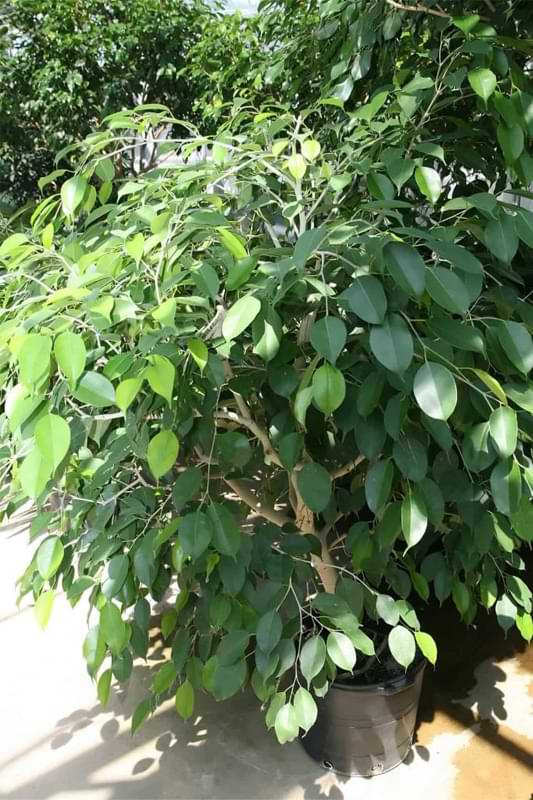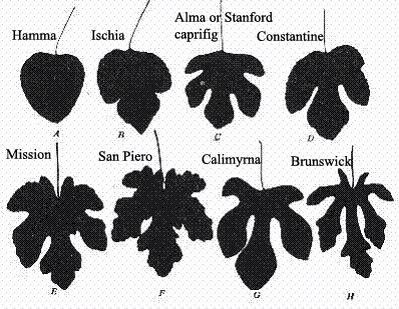Fig leaves are quite distinctive in their appearance, with their large, lobed shape and fuzzy texture. While the edible fig fruit is popular around the world, the fig leaf itself also has many uses. Identifying plants with similar looking leaves can expand your knowledge and introduce new possibilities.
Characteristics of Fig Leaves
Fig leaves grow in a wide palm shape, sometimes called palmate, with 3-7 lobes. The lobes have a finger-like look, with smooth edges Fig leaves can reach over 10 inches long and 7 inches wide
The size and number of lobes may vary based on the fig variety. But in general, fig leaves have a vibrant green color on top and a paler green below. Tiny hairs cover the top surface, giving fig leaves a soft, velvety feel. The protruding veins give fig leaves a wrinkled texture.
Plants with Similar Leaves
Certain other plants produce leaves that look a lot like fig leaves. Getting to know these lookalikes helps with identifying fig leaves correctly.
Chinese Fan Palm
Also called fountain palm, the Chinese fan palm has long, fan-shaped leaves divided into segments. The leaf shape resembles a fig leaf, with a divided look and a triangular outline. But the leaves have a stiff, solid texture rather than fuzzy. Chinese fan palms thrive outdoors in warm climates like Florida.
Amate Tree
Amate trees are tropical trees that grow wild in parts of Mexico and Central America. Their very large deeply lobed leaves look nearly identical to fig leaves. Amate tree leaves can be over 2 feet long! The Amate tree has historical significance as its bark was used to make paper in Mesoamerica before European contact.
Fatsia Japonica
This ornamental plant, also called Japanese aralia, produces lush foliage. The leaves are palmate like fig leaves but with larger teeth along the edges. Fatsia does well as a houseplant or shrub in USDA zones 8-10. Originally from Asia, it produces unique flower clusters in white or light green.
Angel Wing Begonia
While begonia leaves come in many shapes, the angel wing variety has leaves deeply divided into pointed lobes. The leaf shape bears a noticeable resemblance to a fig leaf, especially when the leaves are large. Angel wing begonias thrive outdoors in humid, warm conditions. They also make excellent houseplants.
Fiddle Leaf Fig
One species of fig tree that deserves special mention is the fiddle leaf fig. As its name implies, the leaves look like fiddle-shaped fig leaves. Fiddle leaf fig plants have very large, vibrant leaves with wavy edges. This ornamental fig tree requires bright light and high humidity. It has become a hugely popular houseplant.
Uses for Fig Leaves
While most people are only familiar with the fig fruit, the large lobed leaves have a number of uses, including:
-
Cooking – Fig leaves can be wrapped around meats, fish, cheese or vegetables before grilling or baking to add subtle flavor. Fig leaves are used in some Middle Eastern and Greek recipes.
-
Tea – Dried fig leaves can be used to make an herbal tea. Fig leaf tea is said to offer health benefits like aiding digestion.
-
Essential oil – Fig leaf oil can be extracted through steam distillation. The oil has an earthy, pleasant aroma.
-
Skin care – Historically, the sap from fig leaves was used for skin conditions in Ayurvedic medicine. Fig leaf sap may help soothe inflamed skin.
-
Incense – Dried fig leaves can be bundled and burned as incense due to their sweet, woodsy fragrance.
The next time you come across an unknown leaf that resembles a fig leaf, take a closer look at the texture and growth pattern. Cross-check with the lookalike plants listed here. Fig leaves are an interesting and versatile part of the fig tree that can be used in cooking, herbal remedies, aromatherapy, and more. Getting to know fig leaf lookalikes expands your horticultural knowledge and may even introduce new plants into your garden.
Are Ficus vs fiddle leaf different?
Fiddle leaf figs and ficus trees are sometimes thought to be two different species of plants, while others say they are just different types of the same species. So, what’s the difference between ficus and fiddle leaf figs?.
Ficus is a large genus of plants that includes more than 800 species. Fiddle leaf figs (Ficus lyrata) are just one type of ficus plant. Fiddle leaf figs are native to western Africa and grow best in tropical climates. They are characterized by their large, leathery leaves, which are often variegated or mottled.
Most ficus plants are easy to take care of, and they can grow in a lot of different light conditions, from full sun to low light. They prefer warm temperatures and high humidity, but can also adapt to drier conditions. Fiddle leaf figs are pickier than other ficus trees and need more consistent care to do well.
In a sense, fiddle leaf figs are a type of ficus plant, but they are different from other plants in the same genus in some important ways. As a houseplant, Fiddle Leaf Fig trees and Ficus trees in general are both great options because they don’t need much care and can handle a range of temperatures.
There are so many names for plants that it can be hard to tell when two terms are used to mean the same thing. The bottom line is that yes, Ficus vs. Fiddle Leaf Fig trees are different. Kind of. In short, a Fiddle Lead is a Ficus, but not all Ficus trees are Fiddle Leaf.
In the world of houseplants, the debate of Ficus vs. Fiddle Leaf Fig is a common one among enthusiasts.
Ficus vs. Fiddle Leaf Fig: What is a Ficus?
Ficus is a classification of woody trees, shrubs, and other plants in the Moraceae family. Ficus is a broad word for a lot of different kinds of plants, such as Weeping Figs, Fruiting Figs, Fiddle Leaf Figs, and more.
Ficus trees are generally a tropical tree that prefer temperate climates and are relatively easy to care for. Plant nurseries near you will usually have at least two types of Ficus trees, shrubs, or plants, and sometimes even more. Online plant stores will usually have a wider range for you to choose from. Read more about Ficus vs. Fiddle Leaf Fig trees.
To make informed choices for your indoor garden, delve into the comparison of Ficus vs. Fiddle Leaf Fig.
Weeping Fig trees are a very popular indoor tree. It’s pretty, does well in temperatures that most people keep their homes at, and isn’t too hard to take care of. It has thick, shiny leaves that stand out against the light brown trunk and branches. You can find it in a lot of staged homes and offices.
These trees are pretty tough and can survive in dry places, but to really grow well, they need temperatures between 60 and 80 degrees, the right amount of water, and bright, indirect sunlight.

Exploring the differences between Ficus vs. Fiddle Leaf Fig is crucial for effective indoor plant care.
Rubber plants are also a very popular houseplant. Its botanical name is Ficus Elastica. If you keep them in a pot inside, they get 3 to 6 feet tall. If your climate lets you, you can also plant them outside. Another Ficus tree that needs bright, filtered sunlight to grow well is the rubber plant. It can handle some direct sunlight, but not for long periods of time.
Rubber plants are a shrub-like plant with thin stems and larger leaves. The plant is lovely, and as long as you give it the right amount of light and water, it will brighten up your space for a long time. Continue learning more about Ficus vs. Fiddle Leaf Fig trees.

Ficus Benjamina is just the botanical name for Weeping Fig trees. They look great in the house and can even be grown outside if the temperature stays between 60 and 80 degrees. They can tolerate slightly lower or higher temperatures, but it’s not recommended for an extended amount of time.
A lot of the time, this tree will just be called “Ficus” in stores and plant nurseries, since that’s what most people think of when they hear the word. ”.
Here is more information about Ficus vs. Fiddle Leaf Fig trees. Fruiting Fig trees are also becoming more popular with each new year. Like its botanical relatives, this tree is easy to grow. You can grow this tree in USDA zones 8 and up, but too much heat and sun may hurt it. It’s a bit hardier than other types of Ficus trees, and the figs it makes are delicious!
If you want to buy a fig tree, you should learn about the different kinds so you can choose one that will do well in your area and meet your needs.
Subgenus Ficus is the term used to classify all of the different types of Ficus plants. Ficus plants are a major source of food for many animals in their natural environment, such as monkeys, bats, and birds. They also give us latex, and most of the tree can be used for many things.
The ficus tree is a member of the Moraceae family, which includes over 1,000 species of plants. The fiddle leaf fig is a member of the subgenus Pharmacosycea within the Moraceae family. This subgenus includes only about 150 species of plants.
One of the main differences between these two types of ficus is their appearance. Ficus trees are typically tall with a single trunk, while fiddle leaf figs are shorter with multiple stems. Ficus trees also have smooth, leathery leaves, while Fiddle Leaf Figs have large, wavy leaves.
Another difference between these two types of ficus is their growth habits. In general, fig trees grow quickly and can get up to 100 feet tall. On the other hand, fiddle leaf figs grow more slowly and usually only get to be 10 to 15 feet tall. Most Ficus trees can tolerate a full day of sun, while Fiddle Leaf Figs prefer indirect sunlight.
The Ficus subgenus Sycidium is a group of about 100 species of figs found in the tropics. They are small to medium-sized trees with smooth bark and elliptical leaves. The fruit is a small, fleshy drupe.
The Ficus subgenus Sycidium includes the following species:
- The golden fig tree, also called the yellow fig tree, is native to Mexico, Central America, and the Caribbean.
- The Ficus benjamina, also known as the weeping fig or Benjamin fig, is native to Asia and Australia.
- The red leaf fig, also called the prune fig, is native to Mexico and Central America.
- The Indian rubber tree, or Ficus elastica, is native to India and Nepal. It is also known as the rubber fig.
- The African giant fig, also known as the African banyan, is a species of Ficus ingens.
- The fiddle-leaf fig, also called the trumpet fig, is native to Africa.
There are a lot of different kinds of Ficus trees, even within their own subgenus. This makes the Ficus family of plants very interesting.
The Sycamore Fig (Ficus Sycomorus) has leaves that look like a mulberry. It comes from Africa and the Tropic of Capricorn. It can get up to 65 feet tall, and sometimes it does. Both this tree and the Fruiting Fig tree need a fig wasp to produce fruit. The Ancient Egyptians even called this tree the “Tree of Life.” ”.
There are still many places where this tree grows, but there are some places where the wasp that can fertilize the flower that makes the fruit has died out. In those areas, the tree will still grow, but will not produce the fig fruit.
Subgenus Synoecia is a type of Ficus tree that originated in Asia. It makes figs with a bigger point at the bottom, and it needs to be fertilized by a Fig wasp. The leaves of this subgenus are usually smaller and smoother than some of the other Ficus subgenus.
Some of the most well-known houseplants, like the Fiddle Leaf Fig and the rubber plant, are in the Ficus subgenus Urostigma. These plants are known for their large, glossy leaves and easy-care requirements. While both are great choices for indoor plants, there are a few key differences between these two subspecies.
Fiddle Leaf Figs are native to tropical Africa, while rubber plants are native to Southeast Asia. This means that fiddle leaf figs will require more humidity than rubber plants. If fiddle leaf figs don’t get enough light, they often lose their leaves. Rubber plants, on the other hand, can handle less light.
Ficus Urostigma is similar to the Fruiting Fig, but it does not produce large fig fruit. This subgenus produces smaller, berry-like figs. This Subgenus is even broken down further into different leaf patterns, but each produces these berry-like figs.
12 Tall Houseplants that Look Like Fiddle Leaf Fig
FAQ
What plant looks like a fig leaf?
What is the difference between a fiddle leaf fig and a ficus tree?
What is the difference between ficus and fig?
What do fig leaves look like?
The texture of the fig leaves is generally smooth, and the thickness varied from leaf to leaf. The leaves typically have a veined structure, with the vein protruding on the bottom side of the leaf. Overall, fig leaves are easy to recognize due to their distinct appearance and easily identifiable characteristics.
What are the characteristics of a fig tree?
A fig tree’s leaves are its most noticeable characteristic. With its unique qualities, it is intriguing. Large and distinctively shaped, fig tree leaves appear similar to a hand or a maple leaf. The leaf’s shiny surface displays a vivid green skin that radiates life. Five lobes make up fig leaves.
How do you know if a fig tree has leaves?
Observe the shape of the leaves. The leaves may be oval or oblong like an apple tree or lobed like a fig tree. They may also be long and narrow like mango or peach tree leaves. Notice if the margins around the leaves are smooth or have teeth or spines.
What does a fig tree taste like?
Figs from a fig tree have a sweet taste and a gritty texture. They pair well with cheese and other savory foods. Fig trees can be identified by their leaves, which are bright green in color and have been an iconic symbol since the Bible story of Adam and Eve covering their nudity with the leaves of this tree.
How can I identify a fig tree?
Fig trees can be identified by their bright green leaves, which have been an iconic symbol since the Bible story of Adam and Eve covering their nudity with the leaves of this tree. The leaves are hairy, with the top of the leaves having a coarser hair than the underside. Fig leaves can grow up to 12 inches long.
How do you know if a fig leaf is dry?
Each fig leaf will have 5 lobes. Fig leaves are dry to the touch and may have a texture like thick paper. Feel the leaves to get an even better idea if it’s a fig. Fig leaves feel dry to the touch, not waxy. There may even be a papery or “velcro” feeling to the underside of a fig leaf. Plus, you will be able to feel the veins of the fig leaf.
- The Ultimate Guide to Growing Strawberries in Raised Beds - August 8, 2025
- No-Dig Garden Beds: The Easiest Way to Grow a Beautiful Garden - August 6, 2025
- How to Protect and Preserve Wood for Raised Garden Beds - August 6, 2025

